Yoga for diabetes has become a popular complementary therapy for managing the condition. People with diabetes often struggle with high blood sugar levels, insulin resistance and circulation issues, among other complications. Yoga can do more than give your body a rest – especially if you are suffering from diabetes. Exercising regularly can also help you to cure other complications of diabetes, such as heart disease.
Although yoga has been practiced since ancient times, yoga as a form of medicine is still a relatively new and emerging trend in the field of health.
Some experts recommend yoga for the management of diabetes, which can reduce low blood pressure and low blood sugar levels while improving circulation.
Extensive research has explored changes in biochemical, electrophysiological, cellular, genetic, neuromuscular, and radiological parameters related to yoga practice. It has facilitated the practical application of yoga in various diseases, and is now being recognized as a clinically viable treatment worldwide. Traditionally a mind-body practice with the ultimate goal of spiritual enlightenment, yoga is a science of health management, rather than a therapy for the treatment of specific diseases. 1
Keep reading to find out how these simple tricks can improve your overall quality of life and make significant changes.
Contribution and benefits of yoga in diabetes
It’s considered a promising, cost-effective option in the treatment and prevention of diabetes, data from several studies suggest that yoga and other mind-body treatments may reduce stress-related hyperglycemia and have positive effects on blood control.
Controlling mental stress is a key to the treatment of diabetes when we are under stress, our blood sugar levels rise and high blood sugar levels increase the likelihood of serious complications such as heart disease.
Participants are trained to respond to relaxation using controlled breathing techniques, meditation and body-based postures, yoga, and other mindfulness programs.
This reaction helps regulate cortisol and other stress hormones, leading to increased blood pressure and blood sugar levels, both of which play a large role in the development of type 2 diabetes and related complications.
Yoga can also treat diabetes, may prevent the disease from progressing:
- Rejuvenating pancreatic cells – Yoga poses that aid in relaxation stretch the pancreas, that can stimulate the production of insulin-producing beta cells.
- Muscle exercise – Like other forms of exercise, yoga increases glucose by muscle cells, which in turn helps reduce blood sugar levels, improve circulation and reduce the risk of heart disease.
- Promoting Weight Loss – Exercising through yoga can help reduce weight and improve weight control, both essential to protect against conditions such as diabetes, cancer and heart disease, as well as diabetes management Huh.
- Improving Your Mental Attitude – Yoga practice can help to focus the mind and create the right mental approach to combat diabetes.
While many studies have demonstrated the benefits of yoga therapy, it is not clinically approved in the UK as a treatment for diabetes. Before starting any yoga classes, you should consult with your doctor and diabetes healthcare team and continue with your traditional diabetes care plan.
15 Effective yoga for diabetes
For the diabetic patient, do all the following asana for a minimum of 5–5 minutes, that is, stop in one position for one to two minutes. Repeat 5 to 10 times.
- Apana mudra
- Kapalabhati Pranayama
- Anulom vilom pranayama
- Nadi Shodhana Pranayama
- Supta Baddha Konasana
- Shashankasana (Hare Pose, or Rabbit pose)
- Yoga mudrasana (Psychic Union Pose)
- Vakrasana (Twisted Pose)
- Gomukhasana (Cow Face Pose)
- Ardha Matsyendrasana (Half lord of the fishes pose, or Paripurna Matsyendrasana)
- Purna Matsyendrasana (Full Lord of the fishes pose)
- Halasana (plow pose)
- Dhanurasana (Bow Pose)
- Child’s Pose
- Shavasana
Instructions and benefits of yoga pose, mudra and pranayama for curing diabetes
1. Apana mudra
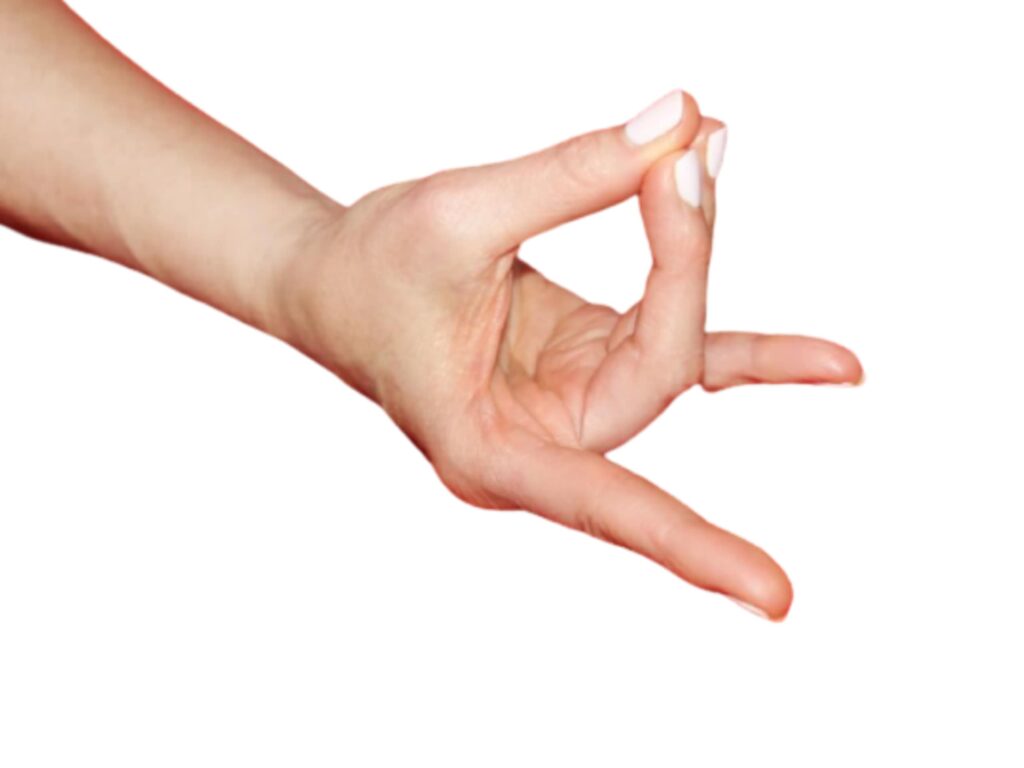
Apana mudra, also known as cleansing energy gestures, or mudra of digestion, means “downward flowing force” and “downward moving air”.
Instructions:
- Sit comfortably on your yoga mat in meditation posture (Sukhasana, or Padmasana, or Siddhasana).
- On each hand, combine the tips of the middle and ring finger with the thumb pad. Keep the index finger and small fingers extended.
- Now, close your eyes and bring awareness to the breath coming in and out of the nostril. Do this for a pair of breaths. This breathing will help you to internalize your mind or consciousness.
Benefits:
- Research done in the past has proved the therapeutic benefits of this yoga mudra in curing diabetes. Especially for type 2 diabetes patients, it promotes deep relaxation and eliminates stress. 1
- Apana mudra can help with all the processes associated with purification, elimination, and the flow of energy. It provides relief from constipation, menstrual cramps and stuck feelings in the body.
- Apana mudra benefits the bladder, uterus, and navel center. Since it helps eliminate impurities and provides a general detox to the entire body system, this pose helps to clear the skin and strengthen immunity.
Note: When you feel excited or hyperactive in mind, try this.
2. Kapalabhati Pranayama (Skull Shining breathing)
Kapalabhati Pranayama, or Skull Shining breathing, is a powerful breathing exercise that not only helps lose weight, but also brings the entire system into a perfect balance.
Instructions:
- Sit comfortably along the spine erect. Place your hands on your knees so that the palms are open towards the sky.
- Take a deep breath in.
- As you exhale, pull the stomach. Draw your navel backwards towards the spine. Do it as comfortably as possible. You can place your right hand on the abdomen to feel the contraction of the abdominal muscles.
- As you relax the navel and abdomen, breathing flows automatically into the lungs.
- Take 20 such breaths to complete 1 round of this Pranayama.
- After completing the round, relax with the eyes closed and observe the sensations in the body.
- Do 2 more rounds of Kapalabhati Pranayama.
Beginner’s tip:
- Kapalabhati Pranayama, or Skull Shining Breathing, techniques are active and powerful exhalation. So, just throw your breath out.
- Do not worry about inhalation, the moment you relax your abdominal muscles, breathing will happen naturally.
- Keep the awareness on breathing out.
- Practice this at home on an empty stomach.
Benefit:
- Increases metabolic rate and aids in weight loss.
- Cleans the nadis (subtle energy channels).
- Stimulates the abdominal organs, and thus it is extremely useful for people with diabetes.
- It improves blood circulation and adds glow to your face.
- Improves digestion, absorption, and assimilation of nutrients.
- Resulted in a tort and trimmed down belly.
- Activates the nervous system and rejuvenates brain cells.
- Calms and uplifts the mind.
Note: Avoid practicing this breathing yoga technique if you are due to an artificial pacemaker or stent, epilepsy, hernia, back pain due to slip discs, or have had recent abdominal surgery.
3. Anulom vilom pranayama (Alternate nostril breathing)
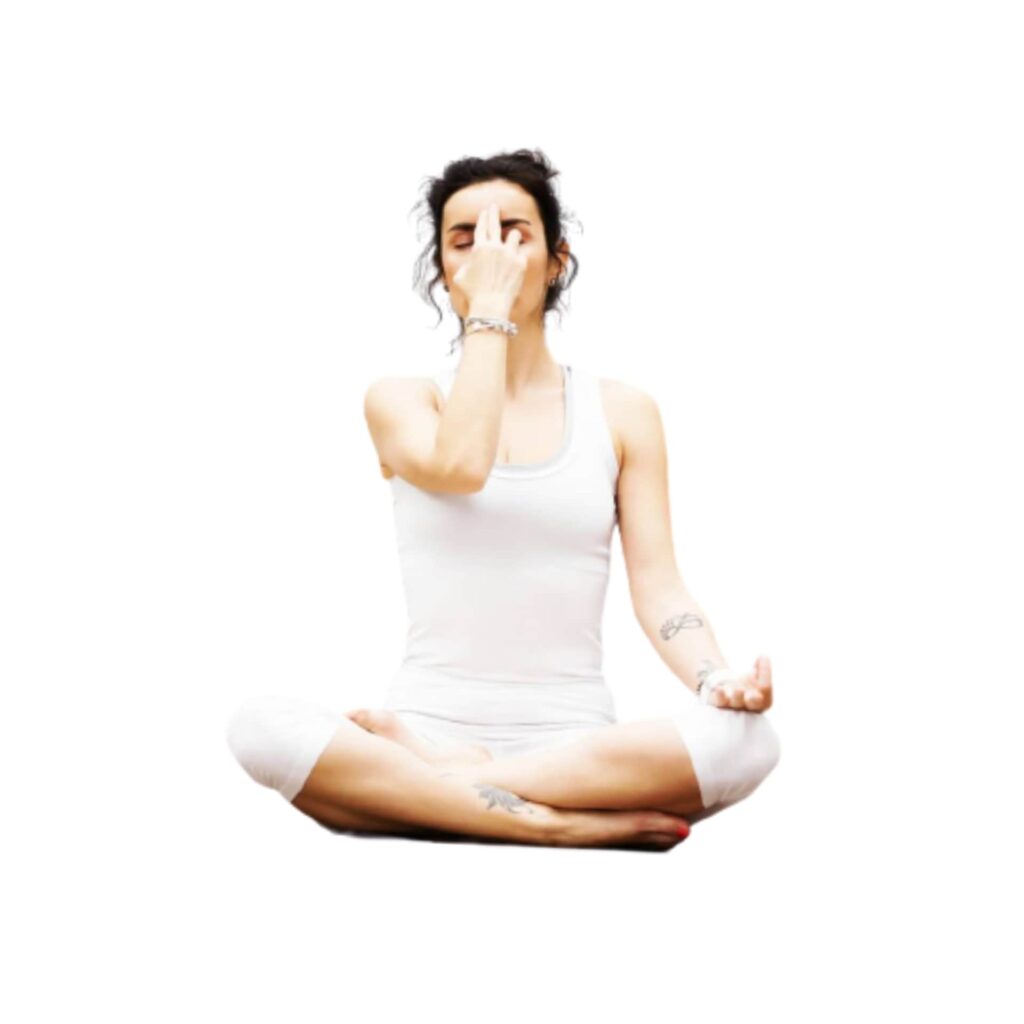
Anulom vilom pranayama should be practice on an empty stomach, preferably 4 hours after the meal. You should also find a quiet, relaxing environment.
Instructions:
- Sit comfortably in any posture, keep your spine and neck straight and close your eyes.
- Clean everything out of this moment.
- Start by resting your outer wrist on your knees.
- Using your right hand, bend your middle and index finger towards your palm.
- Place the thumb on your right nostril and the ring finger on your left nostril.
- Close your right nostril slowly and deeply through your left nostril, through your left nostril until your lungs are full. Pay attention to your breathing.
- Then, release the thumb and close your left nostril with the ring finger.
- Exhale slowly through the right nostril.
- Now reverse it, this time breathe through the right nostril and exhale from the left side.
- Throughout the process, be conscious of your breathing and it affects both the body and the mind.
Note: Try it for 60 seconds or so to start. The first time you try, it may feel a little strange, so do it for as long as you are comfortable.
Benefits:
- It helps to relieve depression, stress, and anxiety.
- Regular practice is considered very helpful and useful in the treatment of respiratory disorders such as asthma, bronchitis, etc.
- Various researches conducted indicate that this alternative breathing has relieved severe health disorders, such as heart problems, severe depression, high blood pressure, arthritis, migraine pain.
- Yoga pranayama helps in keeping diabetes under control.
- Helpful is overcoming negative thoughts. Thinking becomes positive and you can overcome negative emotions like anger, forgetfulness, restlessness, and despair.
- Concentration, patience, attention, decision making ability and invention also increase as the advantages of this pranayama.
- Balances Vata, Kapha and Pitta-3 doshas of the body.
- Improves lung capacity and oxygen throughout the body.
- Streamlines effective pranayama and metabolism for weight loss.
- Common disorders such as constipation, acidity, allergic problems, asthma, and snoring are omitted.
- Excellent workout for a naturally glowing skin.
- Relieves fever, eye anxiety and ear issues.
- Yoga therapy is easy for complete relaxation of mind, body and soul.
4. Nadi Shodhana Pranayama
Instructions:
- Do not be confused with Anulom Vilom and Nadi Shodhana Pranayama.
- Both are same but we hold our breath in pulse refinement.
- First of all, you have to practice the Anulom Vilom Pranayama when you are full then you will go to the next level of Anulom Vilom Pranayama (Nadi Shodhana).
- Nadi Shudh Pranayama is best for balancing the level of tri-doshas in our body.
- To do, sit in Padmasana (lotus posture) Close your eyes. Your spine should be erect.
- Then inhale through your left nostril, while closing your right nostril with your right thumb.
- When you feel that your lungs are full of air, close the left nostril by the ring and middle, and your right nostril should also be closed.
- Hold the breath for a minute or as long as possible, then exhale through the right nostril. Then inhale through the right nostril and close the left nostril with your left thumb, as you completely close your right nostril with the thumb and left nostril.
- Hold your breath (retention) for one minute while exhaling with your left nostril.
- After one cycle is complete, repeat the cycle for 3 or five minutes.
5. Mandukasana
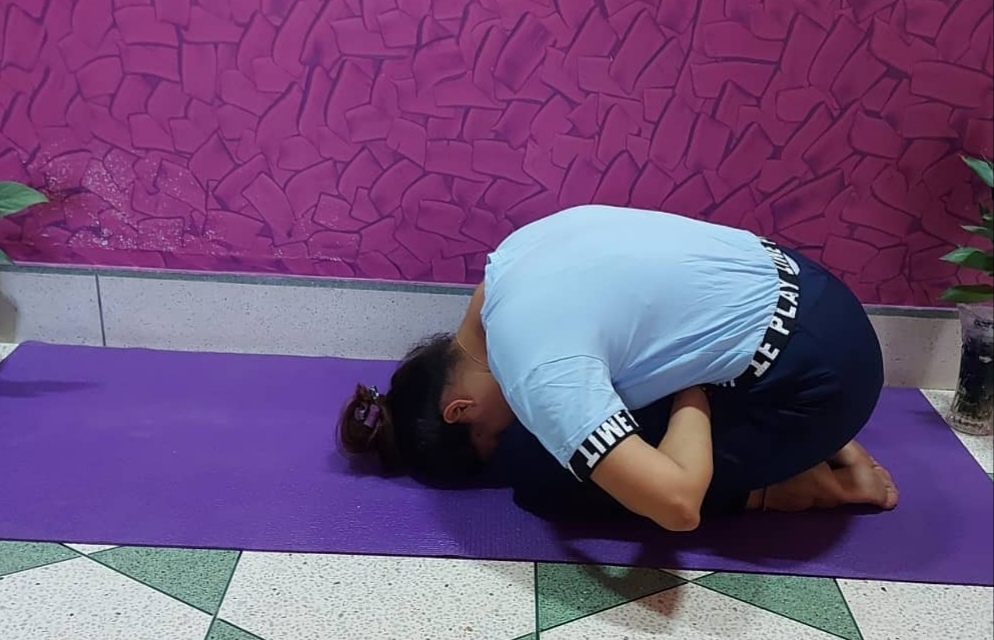
Instructions:
- Sit comfortably in Vajrasana, close the fist of both hands.
- While tying the fist, press your thumb in with the fingers.
- Release the breath while pressing the navel with both your fists and lean forward.
- When you are in the position to bend forward, hold the breath and keep looking straight.
- Stay in this position for some time or hold the position as much as you can, inhale and return to the Vajrasana posture.
- Repeat this three to four times.
Note: People who are suffering from stomach injury and any kind of back pain do not perform Mandukasana. Avoid it in case of knee injury. Ask any yoga expert before doing any kind of asana and pranayama.
Benefits:
- This yoga posture increases the amount of insulin so it is beneficial for curing diabetes.
- Treatment of stomach problems.
- It is beneficial in heart diseases.
- Useful for flexibility of thighs and legs.
- Reduces excess fat from thighs and hips.
- Posture improves the functioning of the digestive system and excretory system.
- Mandukasana cures ankles, knees and back pain.
Mandukasana variation
Instructions:
- Sitting in Vajrasana, placing the palm of the right hand on the palm of the left hand, pressing it on the belly, placing it on the navel, and while exhaling, bow out like Mandukasana.
- Do 3 to 4 time.
Benefits:
- Activates the pancreas. Therefore, insulin starts to form in greater quantity. Hence, Yoga posture is helpful in removing diabetes.
- Useful in stomach diseases.
- Beneficial for the heart.
6. Supta Baddha Konasana (Reclining Bound Angle Pose)
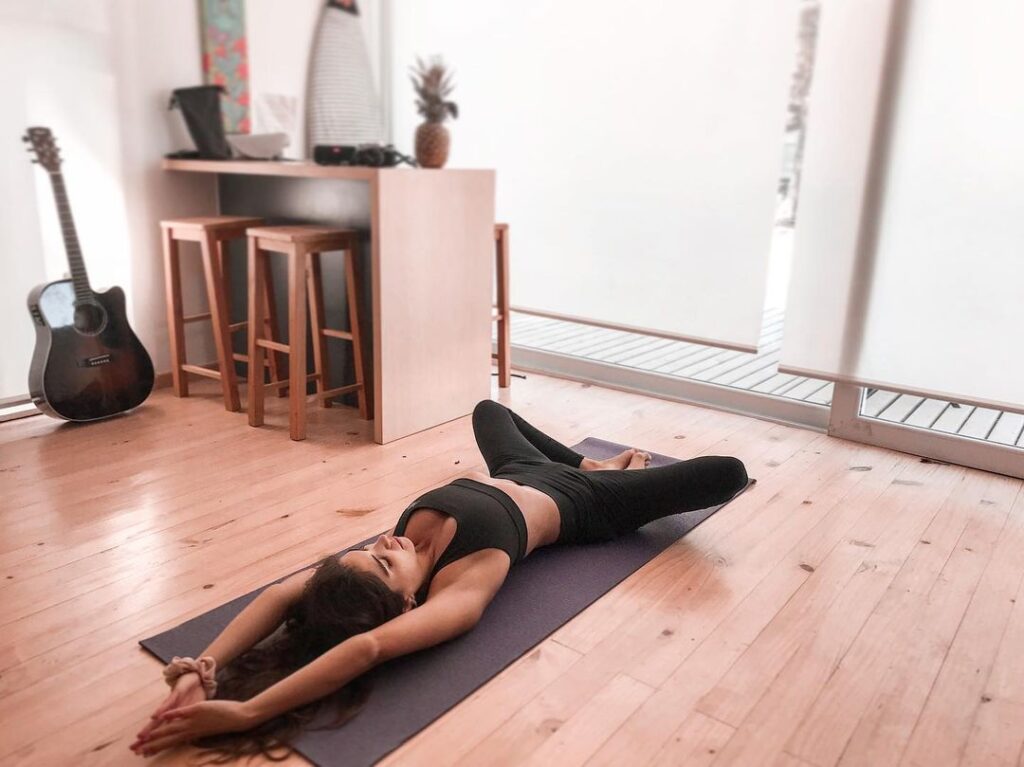
Instructions:
- Start with a seated dandasana, that is, sit with your spine and feet outward, feet touching each other and feet pointing upwards.
- Now bend the knees and bring the feet towards the pelvis. The soles of your feet should touch each other, creating a diamond shape with the feet.
- Hold your feet with your hands. You can put the hands under the feet for support and try to bring the heel as much as possible to the genitals.
- Breathe slowly and make a gentle effort to straighten the chest and spine.
- Once you feel comfortable, you can gently lie down and rest your back on the floor. Your arms can rest on your inner thighs.
- Relax the muscles and take 5-10 deep breaths in this position.
- To release from this posture, you can either stretch your legs and relax for a few minutes. Then roll to your right and rise gently with the help of your hands.
Note: If you are suffering from a groin or knee injury, make sure you place a blanket under the outer thighs for support. Do not use this pose without a blanket. In addition, patients with sciatica should either avoid posture altogether or sit on a cushion to elevate the hips. If you have any lower back disorder, do asana while keeping the spine straight. Avoid leaning forward and round the spine.
Benefits:
- This yoga pose relaxes and calms the mind.
- It opens the groove and hips.
- The group of muscles called hip flexors become tight when you are sitting for a long time. Stretching them can help in relieving and preventing back pain and sciatica.
7. Shashankasana (Rabbit pose)
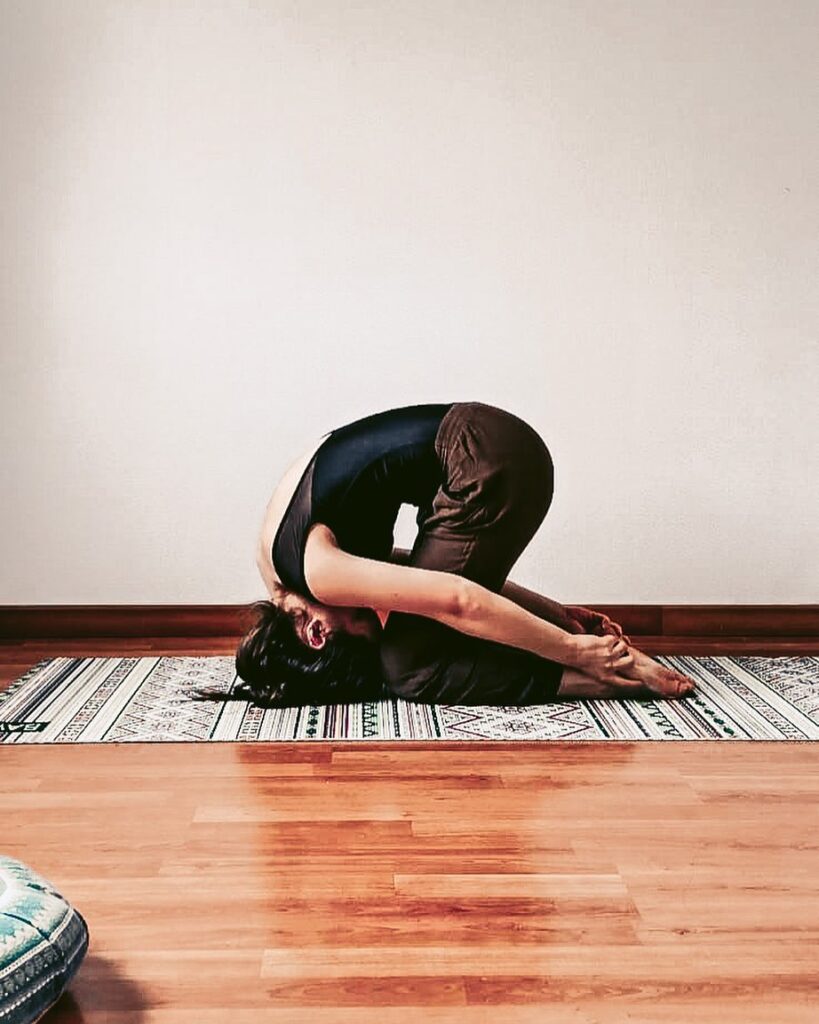
Instructions:
- Begin by sitting on your heel. Exhale, and hold your heels with back of the hands facing out, so thumbs outside, fingers inside.
- Engage the core and round down, placing the top of the head on the ground towards the knees so that the forehead is touching your knees.
- Raise the hips high, roll forward like a wheel until your elbows lock, it feels the amazing opening of the back of your heart.
- Inhale, pull on your heels with a firm grip of your hands and release the breath, go deeper.
- Stay here for at least 5 breaths, and gently come up the same way you came in, inhale and roll-up one vertebra at a time, chin and head last, freeing the hands.
Note: Avoid this asana if you have recent or chronic injuries to the knees, neck, spine, or shoulders.
Benefits:
- Shashankasana gives a good stretch to the upper body including the muscles of the spine and muscles, which puts pressure on the spine.
- Massaging further stimulates the muscles and organs of the stomach, thereby improving digestion.
- The pituitary, pineal, thyroid and parathyroid glands and the immune and endocrine systems are also stimulated in this pose.
- This pose tones the pelvic muscles and relaxes leg muscles and relieves sciatic pain.
- Compression on the feet can reduce varicose veins.
- This yoga pose can also help with sexual disorders (e.g., by strengthening the uterus) and diabetes.
8. Yogamudrasana (Psychic Union Pose)

Instructions:
- Sit in Padmasana, lotus posture. You can use a little cushion or cushion under the buttocks if necessary to make it more comfortable.
- Close your eyes and breathe normally.
- Bring the hands behind the back and hold the left hand with the right. (There is another variation for more advanced practitioners. In this variation, the hands are crossed from behind the back. The right hand grabs the right leg and the left hand grabs the left leg.)
- Slowly lean forward and try to touch the floor in front of the forehead or nose. Exhale while bending forward. If you cannot touch the floor, as far as it goes comfortably without any tension.
- In the final position, relax the entire body, especially the shoulders and back.
- In the situation, you can breathe deeply and slowly. Try to maintain the position for a few minutes.
- Slowly return to the starting position. Breathe back into the staring posture.
- If you are not able to maintain the final state for a long time, the process may take place for some time.
Note: Practice Yoga Mudrasana only if you are able to do Padmasana comfortably for 3–5 minutes. Neither stays in the final position for too long nor forces the body to touch the forehead from the floor. Doing this will stretch the back, ankles, knees, and thighs. Avoid practicing psychic union posture if you are suffering from high blood pressure, knee or ankle complaints, severe back, eye, or heart conditions.
Benefit:
- Best practice for the stomach. Illumines gastritis and removes gas, indigestion, constipation etc.
- By activating the pancreas, it is highly beneficial in controlling diabetes.
9. Vakrasana (Spinal Twist Pose)

Instructions:
- Sitting in Dandasana, bend your right leg and keep it close to the left thigh by the knee, left leg should be straight.
- Bring the left hand between the right leg and abdomen and rest it near the paw of the right foot.
- Keep the right arm straight on the ground behind the waist. By turning the cervix and turning it to the right, the left leg, waist and right hand will remain straight. Can do this 8 to 4 times.
- Similarly, should be done from the other side.
Note: People suffering from any injury to the hips, shoulders, and neck should not do this asana. It should not be performed by those who have undergone any recent surgery of the thoracic, abdomen, or hips.
Benefits:
- Reduces waist fat. It is beneficial for liver and spleen.
10. Cow Face Pose (Gomukhasana)
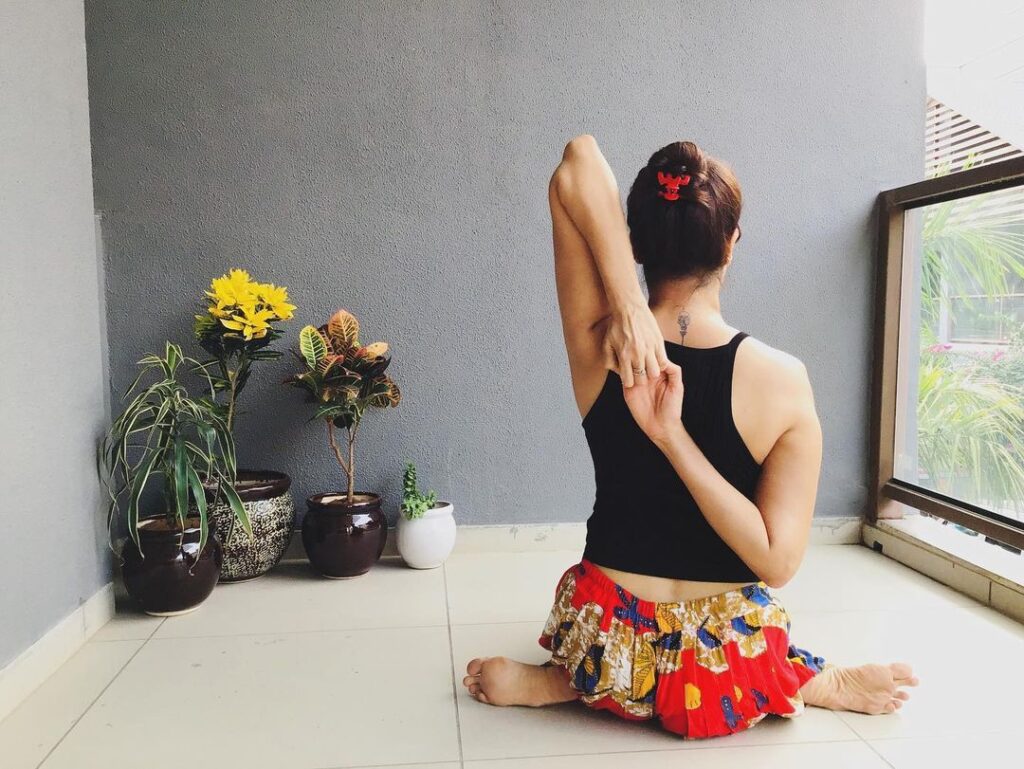
Instructions:
- While sitting in Dandasana, bend the left foot and keep the heel near the right buttock or can also sit on the heel.
- Fold the right leg over the left leg, keeping both knees touching each other.
- With the right hand up, bend it towards the back and take the left hand from behind the back and hold the right hand. Neck and waist should be straight.
- After doing for one minute from one side, do the same from the other side.
Note: Avoid this posture if you have an injury to your shoulder, neck, or knee. Be especially aware of how this pose feels on your knees and motivate yourself accordingly, or leave it if you cannot find a position that causes no knee pain.
Benefits:
- It is particularly beneficial in testicle growth and endothelium.
- It is beneficial in metallic disease, polyuria, and gynecology.
- Strengthens liver, kidney, and thoracic site. Emphasizes Treats rheumatism and arthritis.
11. Ardh Matsyendrasana (Half Lord of the Fishes Pose)

Instructions:
- While sitting in Dandasana, bend the left foot and apply the hip close to the heel.
- Place the right foot outward near the knee of the left foot.
- Hold the paws of the right foot while keeping the left arm straight outward near the right knee.
- Look backwards by turning the right hand from behind the back.
- Similarly, do this asana from the other side.
Benefits:
- It is beneficial in diabetes and back pain.
- All blood vessels in the background (which are spread around the spinal cord) carry blood circulation smoothly.
- Strengthens the intestines by removing stomach disorders.
Purna Matsyendrasana (Lord of Fish Pose)
Instructions:
- Like Ardha-Matsyendrasana, sit and bend the left leg, close it above the navel above the right thigh and keep the right foot bent and hold the paw outward near the knee of the left leg.
- Hold the paw or thumb of the right foot while keeping the left hand out near the right knee.
- Put the right hand back on the back and place it back on the ground.
- In this condition, it should remain for half to 3 minutes.
- This asana should be done from both the right and left sides.
Note: Should not be practiced during pregnancy and menstruation. People with heart, abdominal, spinal or vertebral surgery or brain surgery should not practice. People with peptic ulcer or hernia should be taken care of. It should be avoided for people with severe spinal problems or injuries.
Benefits:
The benefits of full matsyandrasana are also similar to the benefits of half matsyandrasana.
12. Halasana (Plow Pose)
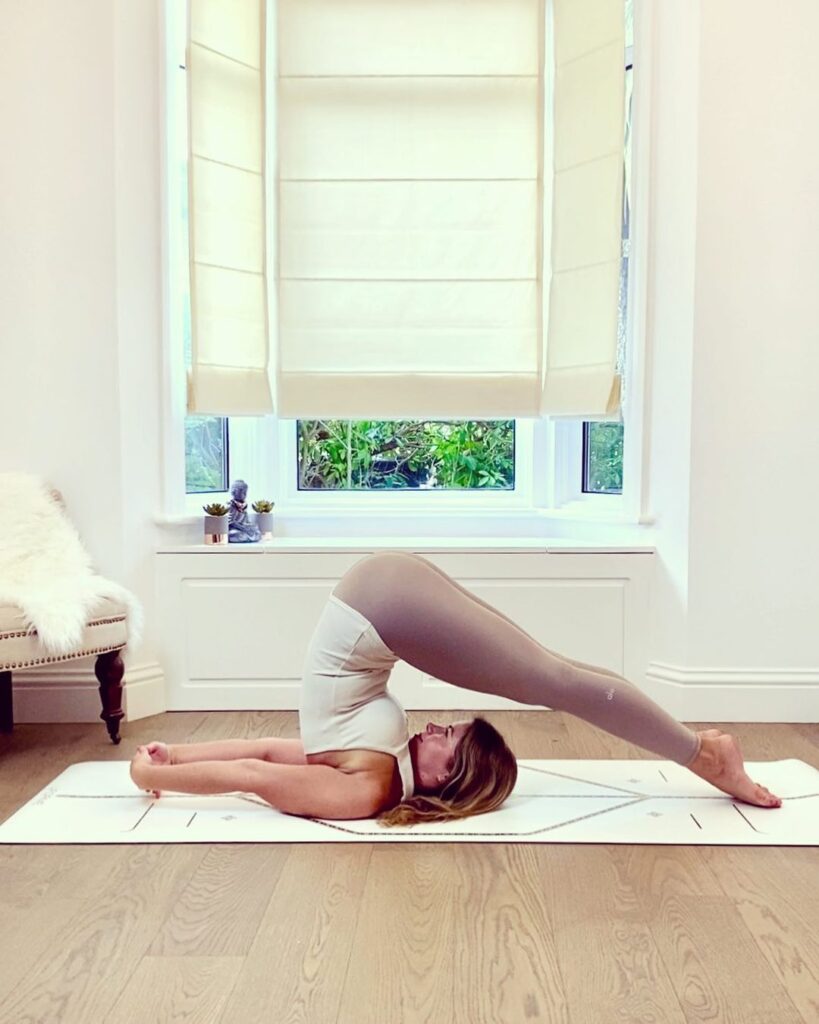
Instructions:
- Lie with your body on your back with your arms extended, palms facing down. Inhale and use the momentum to reach the feet towards the sky.
- Support your lower back with your hands. Press your palms behind your torso to straighten the spine, and press your upper arms into the ground.
- Exhale and slowly lower your toes off the floor, beyond your head.
- Release your hands from your lower back and place your fingers on the floor. Squeeze your shoulders together and place them under you.
- Stay in the plow pose for five minutes. To release, open your hands and place the palms flat on the floor. Move your chin to your chest, exhaling and slowly down to the floor.
Note: People with neck pain, spondylosis, and high blood pressure should not practice this yoga pose. Pregnant women should not do this asana.
Benefits:
- Controls the functioning of all internal organs therefore keeping them healthy.
- Aids digestion, relieves constipation and indigestion.
- Strengthens the immune system.
- Rejuvenate adrenal glands and spleen.
- Improves the functioning of the pancreas, liver, and kidneys.
- Beneficial for female reproductive system organs.
- This yoga pose regulates the production of insulin which prevents diabetes.
- Increases blood circulation in the spinal column and spinal cord.
- Increasing metabolic rate by regulating the functioning of thyroid gland.
- Strengthens the abdominal muscles and reduces back muscle spasms.
- Improves flexibility of shoulders, elbows and wrists.
13. Dhanurasana (Bow Pose)
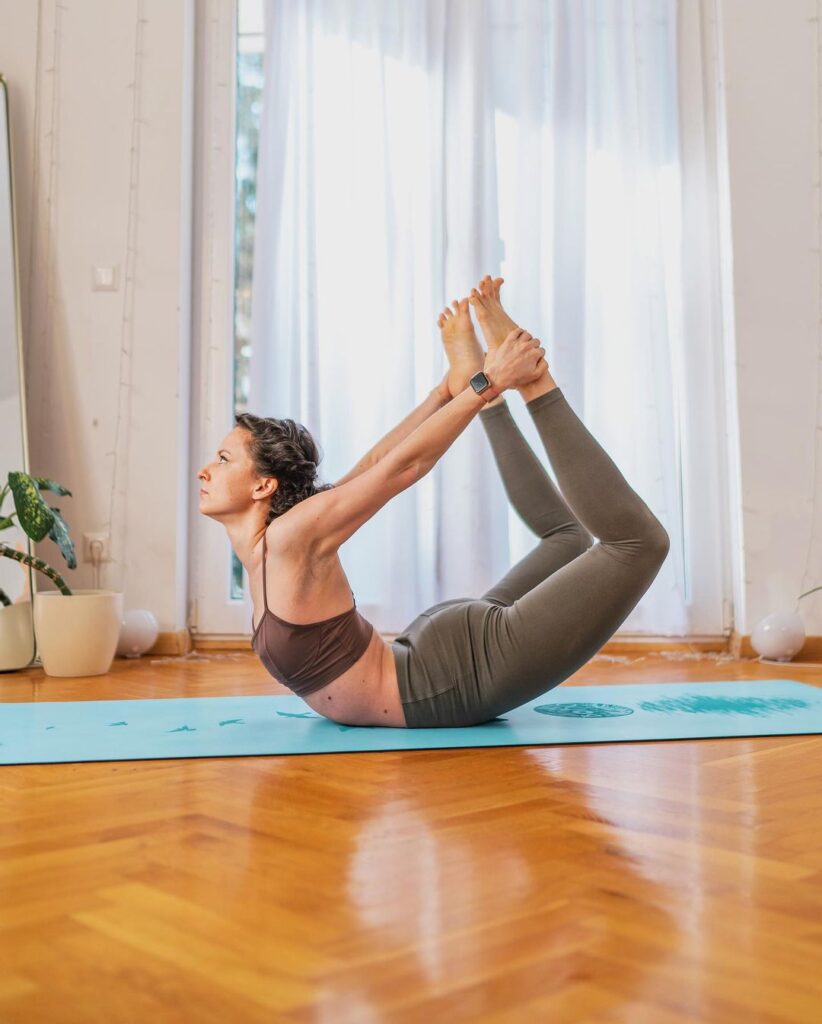
Instructions:
- Lie on your stomach with your feet, with your hips, and your hands from the sides of your body.
- Bend your knees, move your hands backwards, and hold your ankles.
- Inhale and lift your chest above the ground and pull your legs up and back.
- Look straight ahead with a smile on the face.
- Keeping your breath steady the posture, your body is now curved and taut as a bow.
- While taking rest in this posture, take long, deep breaths. But, bow down as far as your body allows you. Do not overdo the stretch.
- After 15 -20 seconds, as you exhale, gently bring the feet and chest to the ground. Release the ankles and relax.
Note: A headache or migraine can worsen if you practice this pose, proceed with caution. If you have an injury or pain in your neck, while doing this pose, bend forward and work to lengthen your neck. If you have a back injury or if you have vertebrae, you want to avoid this posture. People with stomach ulcers or hiatus hernia may feel uncomfortable with abdominal pressure from this pose.
Benefits:
- Bow pose extends the entire front of the body, as well as making every back muscle strong.
- It improves posture and spinal flexibility.
- The pose helps to open the chest, abdomen, quadriceps, ankles, waist, hip flexors, and throat.
- The body’s pressure on the stomach positively stimulates the digestive and reproductive organs, thereby relieving constipation and menstrual discomfort.
- In addition, deep chest stretch opens the lungs, helping to relieve respiratory diseases.
- To energize and energize the body, mind and soul, the Bow pose also helps to relieve fatigue, stress and anxiety.
14. Balasana (Child’s Pose)
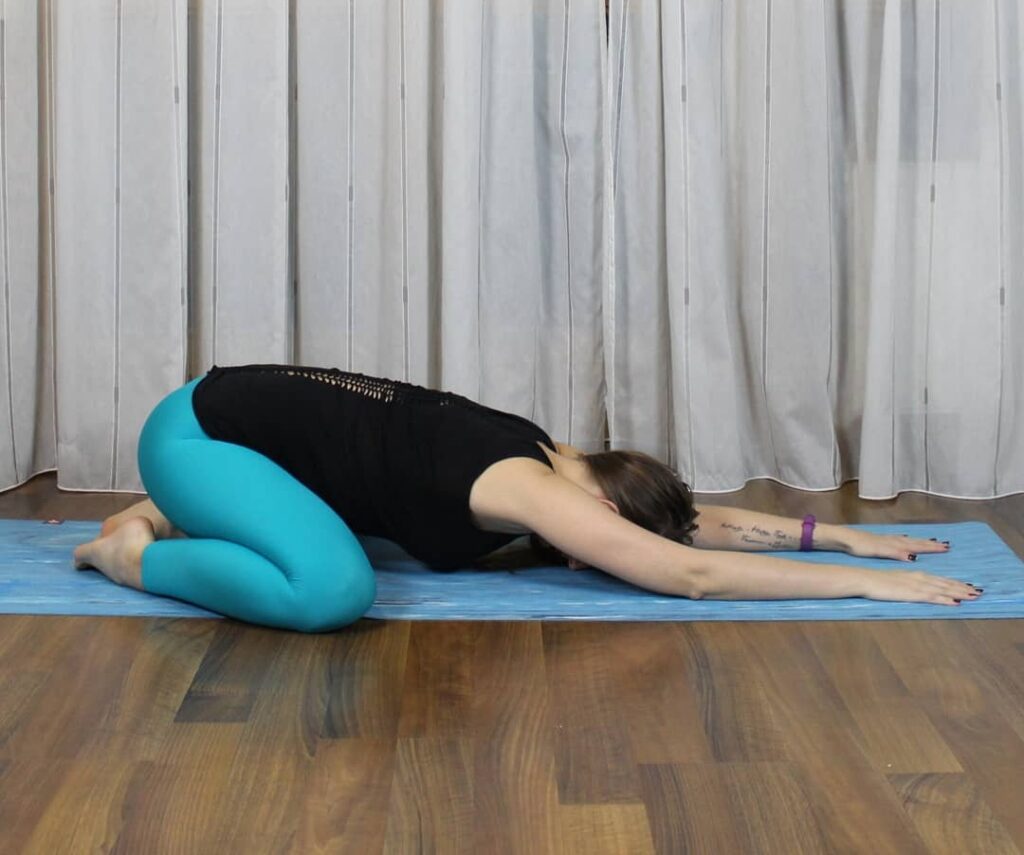
Instructions:
- To start, come to your hands and knees on the mat.
- Spread your knees as wide as your mat, placing the big toes on the floor with the toes touching the top of your foot.
- Bring your stomach to rest between the thighs and root your forehead on the floor. Relax the shoulders, jaws and eyes. If it is not comfortable to place the forehead on the floor, then rest it in a block or two of standing fists. There is an energy point in the center of the forehead between the eyebrows that stimulates the vagus nerve and supports the “rest and digestion” response. Finding a comfortable place for your forehead is key to getting this soothing benefit.
- There are several possible hand variations. You can stretch your arms towards the floor with the palms in front of you or bring your arms with your thighs with the palms facing back. These are the most common changes. But you can pull the palms upward for shoulder release or try to bend the elbows so that the palms touch and rest the thumbs behind the neck. In this position, inch the elbow forward.
- Whichever feels more comfortable for you. If you are doing a lot of shoulder work, another option sounds good.
- Stay for as long as you want, finally reconnecting with your breath remaining and exhaling.
Note: If you find it difficult or uncomfortable to put your head on the floor, you can use a pillow for comfort. If you are suffering from diarrhea or knee injuries, then it is best to avoid doing this asana. Patients with hypertension should avoid the practice of this asana.
Benefits:
- Relieves stress in back, shoulders and chest.
- Recommended if you have dizziness or fatigue.
- Helps reduce stress and anxiety.
- Makes the internal organs of the body flexible and keeps them suppressed.
- It lengthens and extends the spine.
- Walking on the head and torso causes pain in the neck and lower back.
- It gently spreads the hips, thighs and ankles.
- Normalizes circulation throughout the body.
- It extends the muscles, tendons and ligaments in the knee.
- Calms the mind and body.
- Encourages strong and steady breathing.
15. Shavasana (Corpse pose)

Instructions:
- Lie flat on your back, preferably without any support or cushion. Use a small pillow under your neck if necessary. Close your eyes
- Keep your feet apart and relax your feet and knees completely, with toes facing down.
- Keep your arms in the armpits, yet slightly spread from your body. Keeping your palms facing up, leave it open.
- Gently relax your entire body, drawing your attention to different body parts one by one.
- Start with bringing your awareness to the right leg, move to the right knee (as you complete one leg, shift your focus to the other leg), and so on, and slowly move upward of your head. Give each part a rest. Body.
- Slowly, keep breathing deeply and allow your breath to relax more and more. The incoming breath energizes the body while the exhaled breath brings relaxation. Abandon all the meaning of needing to participate in haste or urgency or anything else. Just be with the body and breath. Surrender your body to the floor and let go. Make sure you are not sleeping!
- After 10-20 minutes when you feel completely relaxed, keep your eyes closed, slowly roll to your right. Lie in that position for a minute or two. Then, using your right hand, slowly sit in a sitting posture like Sukhasana (easy posture).
- Keep your eyes closed and take some deep breaths in and out slowly as you slowly become aware of your environment and body. When you feel full, slowly and slowly open your eyes.
Note: If you have low back tenderness or stiffness, a rolled blanket or bolt under your knees helps to get the pelvis in a more comfortable position. If you are pregnant, use a rolled blanket or bolster to elevate your head and chest.
Benefits:
- Although it is sometimes used to begin the practice, Shavasana is often used to end the practice in order to completely relax your body, mind and soul and release tension. It is time to address dull thoughts and worries. From the depth and darkness of Shavasana (Corpse pose), you can be rejuvenated, refreshed and reborn.
- The deep relaxing aspect of Shavasana is considered therapeutic for stress. When you are under stress, your sympathetic nervous system produces a “fight or flight” response that can stimulate your mind and body, causing anxiety, fatigue, depression, and illness. In contrast, the practice of savanna stimulates the parasympathetic nervous system – known as the “rest and digestion” response. Shavasana has many benefits of relaxing the physical body, including:
- Low blood pressure
- Decreased heart rate
- Slow respiration rate
- Decreased muscle tension
- Metabolic rate decrease
- Physical feedback can further result in:
- Reducing the occurrence of headaches
- Relieving fatigue and insomnia
- Reduce nervous stress
- Relief from anxiety and panic attacks
- Increase in overall energy level
- Increasing product
- Better concentration and memory
- A sense of clarity and focus
- Increased confidence
- Raveendran AV, Deshpandae A, Joshi SR. “Therapeutic Role of Yoga in Type 2 Diabetes.” Endocrinol Metab (Seoul). 2018 Sep;33(3):307-317. doi: 10.3803/EnM.2018.33.3.307. Epub 2018 Aug 14. PMID: 30112866; PMCID: PMC6145966.[↩][↩]














